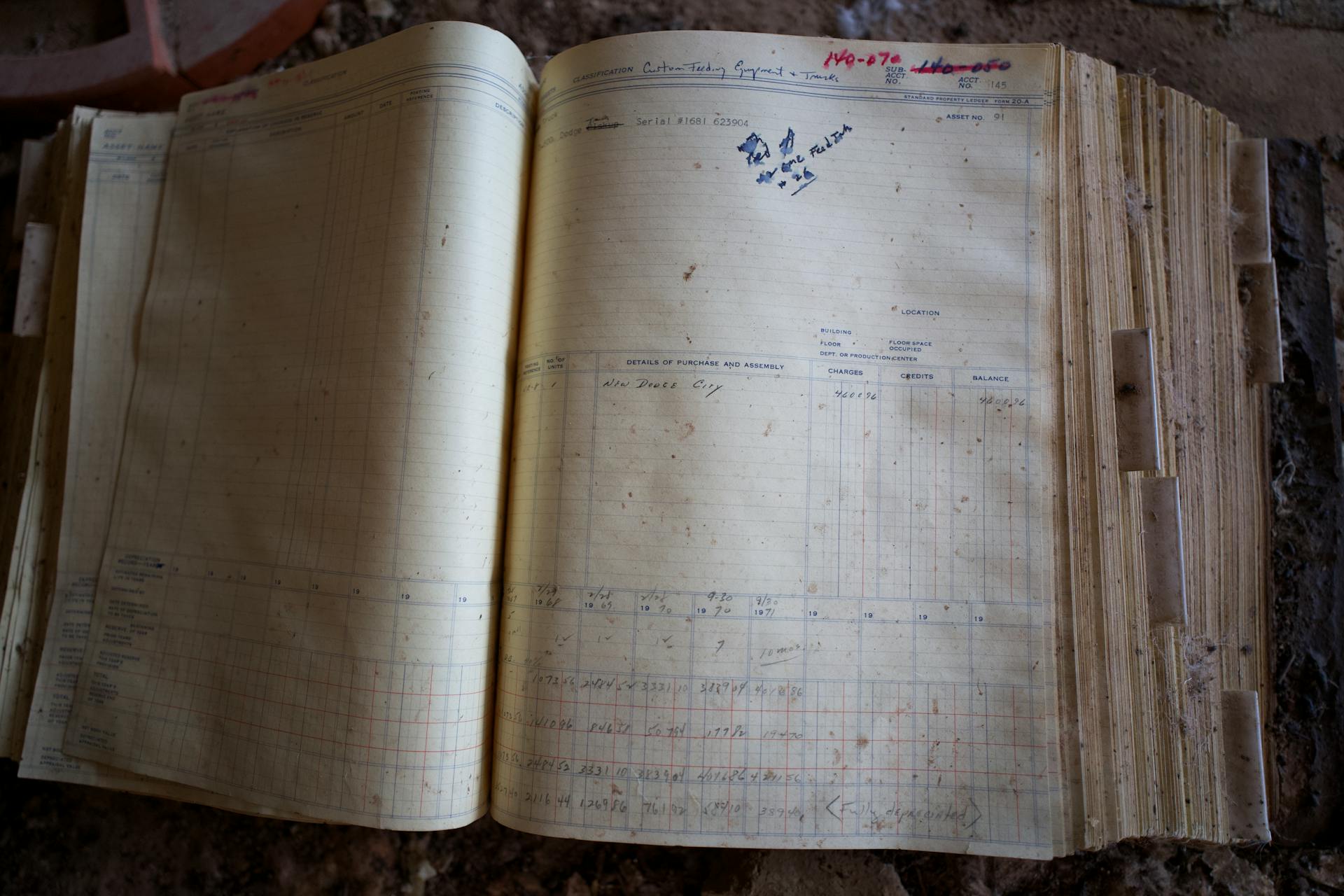
Accumulated depreciation amounts are shown as deductions from assets, and this is done by subtracting the depreciation expense from the asset's cost over its useful life.
The depreciation expense is calculated by dividing the asset's cost by its useful life. For example, if a company purchases a machine for $10,000 with a useful life of 5 years, the annual depreciation expense would be $2,000.
This means that each year, the company would deduct $2,000 from the asset's cost, resulting in a decrease in the asset's value. At the end of the 5-year period, the machine's value would be $0.
Accumulated depreciation is then calculated by adding up all the annual depreciation expenses over the asset's useful life.
Readers also liked: Capital Cost Allowance
Calculating Depreciation
Calculating depreciation is a crucial step in determining the accumulated depreciation amount. There are six accepted methods for calculating depreciation under generally accepted accounting principles (GAAP): straight line, declining balance, double-declining balance, sum-of-the-years' digits, units of production, and half-year recognition.
The straight-line method is the simplest and most common, dividing the depreciable cost evenly over the asset's useful life. For example, if a company purchases a piece of machinery for $20,000 with a useful life of 10 years, the annual depreciation expense would be $2,000.
The declining balance method accelerates depreciation, offering higher deductions earlier in the asset's life. This method involves multiplying the book value at the beginning of the year by a multiplier, which is typically 2 or more.
There are two common accelerated depreciation methods: Double Declining Balance (DDB) and Sum of the Years' Digits (SYD). The DDB method involves calculating the straight-line depreciation rate and then doubling it, while the SYD method involves summing the digits of the asset's useful life and assigning a fraction to each year.
To calculate accumulated depreciation, the annual depreciation expense for the asset must be determined using approved depreciation methods. The accumulated depreciation formula is: Accumulated Depreciation = Annual Depreciation Expense x Number of Years the Asset Has Been Used.
Here are the six accepted depreciation methods:
- Straight line
- Declining balance
- Double-declining balance
- Sum-of-the-years' digits
- Units of production
- Half-year recognition
The MACRS depreciation method involves specific rules and tables provided by tax authorities. For accurate calculations, refer to the appropriate guidelines and tables.
Depreciation in Financial Statements
Accumulated depreciation is reported on the balance sheet as a contra-asset account, reducing the overall value of the fixed assets owned by the company.
It is a crucial element in financial statements, impacting the balance sheet of a company, and is recorded as a deduction from the asset's original cost.
Accumulated depreciation is not an expense or an asset, but rather a contra-asset account that reflects the reduction in an asset's value over time due to depreciation.
The value of an asset on a company's balance sheet is determined by subtracting the accumulated depreciation from the asset's cost.
Accumulated depreciation is calculated using one of six methods: the straight line, declining balance, double-declining balance, sum-of-the-years' digits, units of production, and half-year recognition.
Here are the six methods of calculating accumulated depreciation:
Accumulated depreciation is a non-cash transaction, which means that it doesn't involve any actual cash movement but is still recorded for accounting purposes.
Consider reading: Is Depreciation a Cash Expense
It is essential to ensure that the figures are consistent and accurate, as this directly impacts the company's total assets and the overall financial position.
Accumulated depreciation is recorded on the balance sheet as a contra-asset account, appearing directly below the corresponding asset account.
The net book value of an asset is calculated as the cost of the asset minus the accumulated depreciation.
Accumulated depreciation reduces the net book value of an asset over time, giving a clear and accurate representation of its diminishing value.
Accumulated depreciation is a crucial element in financial statements, and its accurate calculation and recording are essential for making informed business decisions.
Methods
Accumulated depreciation amounts are shown as deductions from the asset's original cost on the balance sheet. This is achieved through various depreciation methods, which allocate the depreciation expense differently over the asset's useful life.
There are six accepted methods for calculating depreciation that are allowable under generally accepted accounting principles (GAAP). These methods include the straight-line, declining balance, double-declining balance, sum-of-the-years' digits, units of production, and half-year recognition methods.
The straight-line method is the simplest and most common, dividing the depreciable cost evenly over the asset's useful life. This method is often used for assets with a relatively long useful life.
The declining balance method accelerates depreciation, offering higher deductions earlier in the asset's life. This method is useful for assets that depreciate quickly, such as machinery.
The double-declining balance method further accelerates depreciation, allocating a larger portion to the first few years of life. This method is often used for assets that depreciate rapidly, such as computers.
Here are the six accepted depreciation methods:
- Straight line
- Declining balance
- Double-declining balance
- Sum-of-the-years' digits
- Units of production
- Half-year recognition
Ultimately, selecting the most suitable depreciation method requires consideration of the asset's nature, expected usage, and the most accurate reflection of its decline in value over time.
Depreciation and Tax Implications
Depreciation is a key concept in accounting and taxation, and it's essential to understand the differences between book and tax depreciation.
Book depreciation is recorded as a depreciation expense on the income statement, reducing net income, while tax depreciation is a tax deduction that reduces taxable income.
You might enjoy: Unrelated Business Income Tax
The Modified Accelerated Cost Recovery System (MACRS) is the most common depreciation method for tax purposes, allowing businesses to recover investments in tangible property over a specified recovery period.
The MACRS method accelerates the depreciation rate compared to the straight-line method, resulting in a higher depreciation expense in the earlier years of an asset's life.
Here's a comparison of the straight-line and MACRS methods:
By understanding depreciation and its tax implications, businesses can manage their wealth more efficiently by reducing taxable income and optimizing asset investments.
What is Tax?
Tax is a significant aspect of depreciation, and understanding it can help businesses save money. Tax depreciation is a depreciation expense listed by a business on their tax return for a given tax period.
It's a way for businesses to reduce their taxable income and the tax amount owed. By claiming depreciation expenses, businesses can recover the costs associated with capital assets, such as machinery, buildings, and equipment.
The IRS requires that an asset be owned by the business, used in a business or income-producing activity, have a determinable useful life, and be expected to last more than one year. This means that businesses can only depreciate assets that meet these criteria.
For example, a business client buys a new company truck that is used only for business purposes. Each year, the truck will continue to lose its value as it is used and miles accrue. Tax depreciation enables the client to reduce their tax liability and save money by deducting from the taxes a portion of the truck’s declining value.
Here are the key requirements for tax depreciation:
- Property must be owned by the business.
- Property must be used in a business or income-producing activity.
- Property must have a determinable useful life.
- Property must be expected to last more than one year.
Tax Implications
Depreciation is a powerful tool for reducing taxable income and optimizing asset investments. By allocating the cost of tangible assets over their useful life, businesses can lower their taxable income and decrease their tax liability.
Depreciation can be calculated using various methods, including the straight-line method and accelerated methods like MACRS. The straight-line method is a simple and straightforward approach, where the cost of an asset is divided by its useful life to determine the annual depreciation expense. For example, an industrial machine with an initial cost of $50,000 and a useful life of 10 years would have an annual depreciation expense of $5,000 using the straight-line method.
If this caught your attention, see: Deferred Income Tax
The MACRS method, on the other hand, accelerates the depreciation rate compared to the straight-line method, allowing businesses to claim a higher depreciation expense in the earlier years of an asset's life. This can help businesses achieve better cash flow and reduce their overall tax liability. To apply MACRS depreciation, businesses need to follow specific steps, including determining the applicable asset class and selecting the appropriate recovery period.
Here are the general steps to calculate MACRS depreciation:
It's essential for businesses to consult with a tax professional to ensure correct application of MACRS and proper reporting of depreciation expenses on tax returns.
Depreciation Accounting and Principles
Accumulated depreciation amounts are shown as deductions from the asset account on the balance sheet. This is because accumulated depreciation is a contra asset account, meaning it has a natural negative balance that offsets the balance of the associated asset account.
A few key characteristics of contra asset accounts, such as accumulated depreciation, are:
- Negative balance: Contra asset accounts hold a negative balance that reduces the overall value of an asset on the balance sheet.
- Impact on book value: The net impact of accumulated depreciation on the book value of an asset is a decrease in the asset’s value over time.
- Non-cash: Accumulated depreciation is a non-cash transaction, which means that it doesn’t involve any actual cash movement but is still recorded for accounting purposes.
Accumulated depreciation is not an expense or an asset, but rather a contra-asset account that reflects the reduction in an asset’s value over time due to depreciation.
What Is Book?
Book depreciation is the amount recorded in a business's financial statement for a fixed asset that is allocated over its useful life. This non-cash business expense is guided by accounting principles and standards.
The straight-line method is the most common and simplest method of book depreciation. It calculates the annual depreciation expense by dividing the difference between the asset's cost and salvage value by its useful life.
For example, let's say a business owner purchases a new piece of machinery for $5,000. The salvage value is estimated to be $2,000, and its useful life is five years. Using the straight-line method, the annual depreciation expense would be $600.
Depreciation recognizes the normal wear and tear that occurs from the usage of the asset. Despite care and maintenance, assets will decrease in value over time.
The straight-line method formula is ($5,000 - $2,000) / 5 = $600 annual depreciation expense.
Expand your knowledge: What Is Salvage Value in Economics
Accounting Principles
Accumulated depreciation is a contra asset account, which means it has a negative balance that offsets the balance of the associated asset account on the balance sheet.
A contra asset account like accumulated depreciation has a few key characteristics. It has a negative balance that reduces the overall value of an asset on the balance sheet. This negative balance grows as time passes and the asset depreciates.
The net impact of accumulated depreciation on the book value of an asset is a decrease in the asset's value over time. This means that as the asset depreciates, its value on the balance sheet decreases.
Accumulated depreciation is a non-cash transaction, which means that it doesn't involve any actual cash movement but is still recorded for accounting purposes. This is an important distinction in accounting.
Accumulated depreciation is not an expense or an asset, but rather a contra-asset account that reflects the reduction in an asset's value over time due to depreciation.
Here are the key characteristics of contra asset accounts:
- Negative balance: Contra asset accounts hold a negative balance that reduces the overall value of an asset on the balance sheet.
- Impact on book value: The net impact of accumulated depreciation on the book value of an asset is a decrease in the asset's value over time.
- Non-cash: Accumulated depreciation is a non-cash transaction, which means that it doesn’t involve any actual cash movement but is still recorded for accounting purposes.
Sources
- https://tax.thomsonreuters.com/blog/what-is-the-difference-between-book-and-tax-depreciation/
- https://www.investopedia.com/terms/a/accumulated-depreciation.asp
- https://www.taxfyle.com/blog/understanding-accumulated-depreciation
- https://finally.com/blog/accounting/accumulated-depreciation/
- https://www.investopedia.com/ask/answers/040215/what-relationship-between-accumulated-depreciation-and-depreciation-expense.asp
Featured Images: pexels.com


